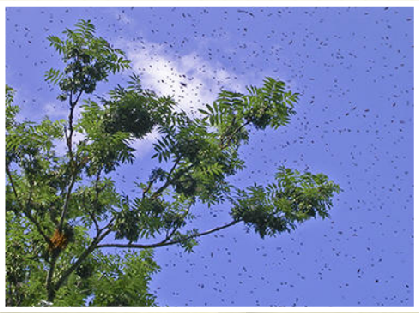


apiculture n. beekeeping
apiarist n. one who keeps bees
apiary n. a place where bees are kept
© Okehampton Branch of the Devon Beekeepers Association 2024 -
If you think you have a swarm of bees then please check the bee identification chart by clicking on this icon.
bees then please check the bee identification chart by clicking on this icon.
If you need help with a swarm in the Okehampton area then please contact our Swarm Liaison Officer:
Mark Tanner
Mobile Phone Number: 07710 651313
We will help you if we can but there are occasions when it may be impossible or dangerous to remove the bees and we may have to refer you to an alternative solution.


A sky full of bees marks the arrival of a swarm which is beginning to settle in this Ash tree (bottom left of picture)
Honeybee swarm clustered in a bush
A lot of bees on flowers is NOT a swarm -
HONEY BEES are slender, mostly brown with lighter bands and a little over half an inch long. These are the only bees kept by beekeepers. Honey bees may vary in colour, from almost black (like a house-
The public are most likely to encounter honeybees in their garden or a park. The bees will be going about their business collecting
Nectar or Pollen.
If a large quantity of bees is present in one small area, then they are in the early stages of swarming. This is a critical activity for honey bees, as it is their means of colony reproduction. Despite all their activity, they are not usually aggressive to humans during this stage of their lives.
If a swarm is in progress, you will see a lot of bees flying and milling about over perhaps a ten to twenty metre area – the air will appear ‘thick with bees’. If you watch carefully from a safe distance, you will see the activity is centred around a cluster of bees on a branch (or sometimes a man-
This is a SWARM -
You may also find honey bees that have taken up residence in parts of buildings; cavity walls via air-
It may be possible to remove the bees, depending on access and structural considerations. Very, very occasionally you may come across a swarm cluster that has forgotten to move on and has taken up permanent residence where it clustered, usually in a thick, well-
The removal of honey bee colonies from structures needs to be planned by experts. Do not attempt it yourself because, even if you kill the honey bees, you will leave behind a lot of their honey which will attract other honey bees and wasps, so you will be back to where you started. Any residual pesticide used to kill the colony will be picked up and most likely be transferred to managed colonies of honey bees and kill them.

Beekeeper hiving a collected swarm -